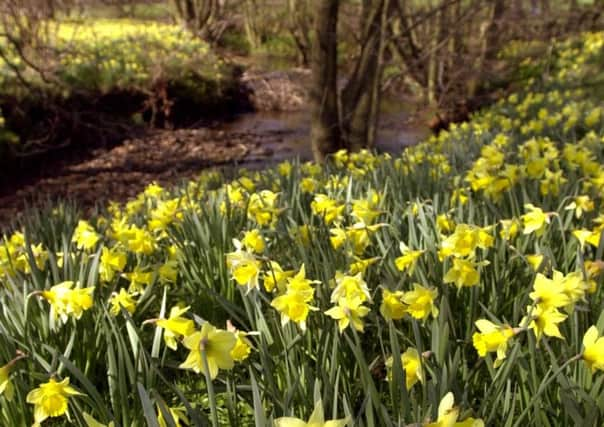Your Day Out: Blooming fields of gold


There is no village called Farndale, just three hamlets – Lowna, Low Mills and Church Houses.
Low Mills derives its name from having two cornmills, and Church Houses is near the church. The picturesque cottages and farm houses are built of local sandstone.
Advertisement
Hide AdAdvertisement
Hide AdFarndale’s greatest claim to fame are the wild daffodils, which stretch along this narrow dale north of Kirkbymoorside. Between late March into May, they throng the banks of the River Dove for about five miles. This golden display is usually at its finest in mid-April, and worth waiting for. Go early morning or evening to avoid the crowds of visitors.
They were possibly planted there by the monks of Rievaulx. Others believe Nicholas Postgate, the Egton Bridge martyr may have introduced them. Thankfully, the area is now protected by the Nature Conservancy Council. At one time, visitors picked the blooms, sometimes in sackfuls, or even removed complete plants! Now, voluntary wardens guard this golden treasure while in bloom. This nature reserve is protected by law. Surprisingly coal, ironstone, gravel and jet have all been worked here! Enjoy the contrasting scene nowadays.
Make your way from the A170 northwards, to park at Low Mill car park. There’s usually a small parking fee to pay. Public conveniences are nearby, and in season the North York Moors National Park have a prominent stand there.
While we’ve enjoyed several excellent walks in this area, the most popular for all ages, and providing easy walking in all weathers, along with available refreshments, is detailed here.
Advertisement
Hide AdAdvertisement
Hide AdStart from the car park, and you’ll see a sign indicating the public footpath to High Mill. A firm, clearly demarcated route with about 18 gates, crosses sheep pasture, so please leash any dogs and close the gates after use.
Enter the handgate, and cross the River Dove. A second handgate guides you on your way to High Mill, with a possible short extension to Church Houses and the Feversham Arms Inn. Now just relax and enjoy wild flowers; bird song; fields; woodland, and rippling waters, with Blakey Ridge rising to the east horizon.
When well on your way, at about the 17th gate you’re approaching the Daffy Caffy. Two or three fields and flagstone paths lead to a field gate, and Daffy Caffy tea room at High Mill, open 9am-5pm in season.
Feeling refreshed, you may decided to go ahead to the hamlet of Church Houses, meeting the road near the Feversham Arms Inn. So – you have two options for refreshment, before returning along your out-going route. You can’t get lost, and the scene looks quite different in reverse.
Advertisement
Hide AdAdvertisement
Hide AdAs with many remote, farming communities, myths and legends arise over the centuries. One of Farndale’s concerns a hob, or elf-like creature, believed to live on a rocky out-crop high on the moors. For some reason he arrived at one of the farms in the dale to help out in a voluntary capacity when one of the farm labourers died. Becoming attached to the Gray’s family, he remained there for successive generations. Working invisibly mowing, shearing, threshing, milking, and feeding stock, he also seemed to protect the entire farmstock.
Happy in his labours, he sought no reward other than a jug of cream, which was always left for him in the barn as evening fell. Sadly, tragedy followed when Jonathan Gray’s wife died at an early age. Jonathan was devastated, and despite consolation by the hob, he realised he needed a wife. Eventually he remarried, but his new wife was somewhat mean. Hearing the routine of leaving a jug of cream in the barn every night for the hob, made her laugh him to scorn. It was a ridiculous idea and a waste of money! Jonathan pleaded with her to continue the ritual. Eventually she agreed, but cheated by exchanging the jug of cream for one of skimmed milk. The hob would never know the difference, or so she thought.
Almost immediately, things began to happen. The hob refused to work, and instead played wicked pranks. He made the cheese turn sour, and the cows yield little milk. The crops began to fail, and livestock fell sick. Some evil spirit terrified all who lived and worked there, and haunted the farmhouse. No-one would work for Jonathan Gray and he could not sleep for worrying about his future. What was he to do?
You probably know the ending of this legend. It most certainly held a moral, didn’t it?
Distance of walk: 3 miles return, or 3.5 miles approximately to include Church Houses.
Refreshment: The Daffy Caffy at High Mill, and the Feversham Arms in Church Houses.